Great+Chain+of+Numbers+A+Guide+to+Smart+Contracts,+Smart+Property+and+Trustless+Asset+Management+-+Tim+Swanson
Great+Chain+of+Numbers+A+Guide+to+Smart+Contracts,+Smart+Property+and+Trustless+Asset+Management+-+Tim+Swanson
Great+Chain+of+Numbers+A+Guide+to+Smart+Contracts,+Smart+Property+and+Trustless+Asset+Management+-+Tim+Swanson
Create successful ePaper yourself
Turn your PDF publications into a flip-book with our unique Google optimized e-Paper software.
Chapter 3: Next Generation Platforms<br />
As innovative and groundbreaking as Bitcoin has been, it has several known technical limitations. 102<br />
Simultaneously, the current development team is hard at work on priorities revolving around improving<br />
the security of the protocol from vulnerabilities and exploits. 103 This is not a criticism of their activities<br />
and actions, especially in light of the transaction malleability issue that caused frenetic activity within<br />
the ecosystem during the middle of February. 104 Other developers in the community have tried to<br />
assume the mantle of responsibility for improving the functionality and capabilities of this space. Some<br />
projects involve fusing exoskeleton systems built around the Bitcoin protocol; others create their own<br />
independent ledgers; still others have even created bridges between Bitcoin and other ledgers.<br />
Below, I introduce eight projects that are currently developing a mechanism to design and transport<br />
smart contracts or smart contract functionality. 105 For each, I attempted to interview the main<br />
developers.<br />
Colored Coins<br />
As noted above, one way to utilize a crypto blockchain to verify wares is through a process being<br />
developed called Colored Coins. 106 In a nutshell, this endeavor allows users to “color” a token to<br />
represent a specific asset such as a car, home, boat, commodity, a share, a bond – virtually any type of<br />
asset (e.g., 0.5 BTC colored green to represent your home). These tokens can then be exchanged, just<br />
like bitcoin tokens, by anyone anywhere. This enables a decentralized, trustless form of asset<br />
management that uses a blockchain as both a ledger and transportation mechanism.<br />
Alex Mizrahi, who is leading the development of the Chroma Wallet used by the Colored Coins project<br />
says that “it is going to be very easy for the asset management industry as a whole to use Colored<br />
Coins. 107 For example, some of the first places we are going to have adoption will likely be real-estate<br />
and portfolio management. In fact, for any type of asset management it’s going to be simple to issue his<br />
own color that represents his goods. A portfolio manager can issue one color that represents a portfolio<br />
of stocks backed by the real holding and sell it globally. If he is savvy and his products are good, his<br />
colors are going to have demand. So transferring ownership is very easy, quick and safe — just like<br />
bitcoins. In the real estate industry someone can issue their apartments using colored coins and have<br />
them float on the blockchain, or manage time-sharing based on color.” 108<br />
Meni Rosefeld, another member of the development team, described several of the advantages of using<br />
a secondary attribute (color) within the asset management industry. “The greatest advantage is the<br />
removal of barriers of entry. Currently, new businesses wishing to raise capital use cumbersome and<br />
inefficient private deals; and those aspiring to be listed in order to allow for the market to valuate them<br />
with an efficient mechanism, can only do so with a great expenditure. With colored coins, anyone can<br />
easily raise funds in exchange for equity, removing barriers of entry, encouraging innovation and<br />
allowing society as a whole to better allocate its resources between ventures.”<br />
One area of confusion within the Bitcoin community is the misplaced understanding – that centralized<br />
servers are needed to issue and track a secondary attribute (the “color”). According to Rosefeld, this is<br />
incorrect. “No centralized servers are needed for tracking – this is done in the decentralized network of<br />
the host currency (such as Bitcoin). There does need to be an entity issuing each particular colored coin<br />
– however, an entity raising funds for a generic purpose is not usually in the business of running an<br />
exchange. Without colored coins, they would have to resort to a large 3rd party exchange with all the<br />
31


